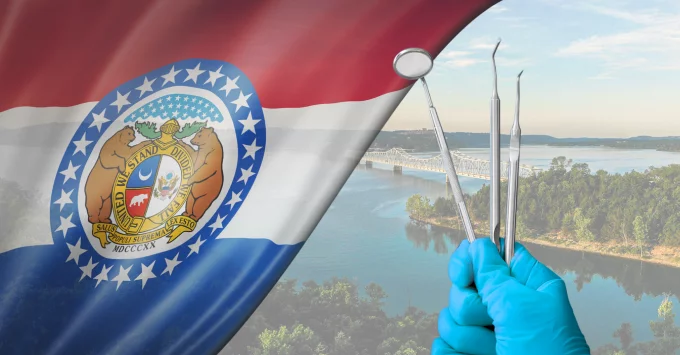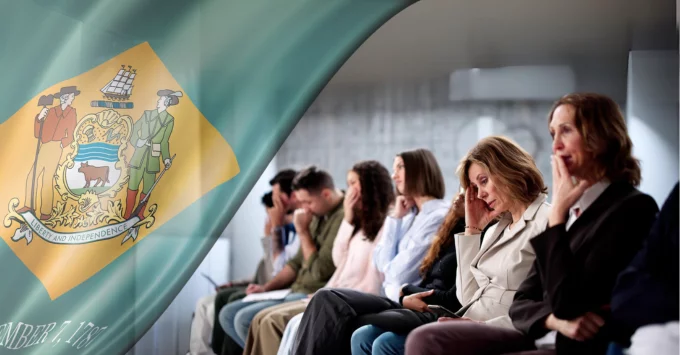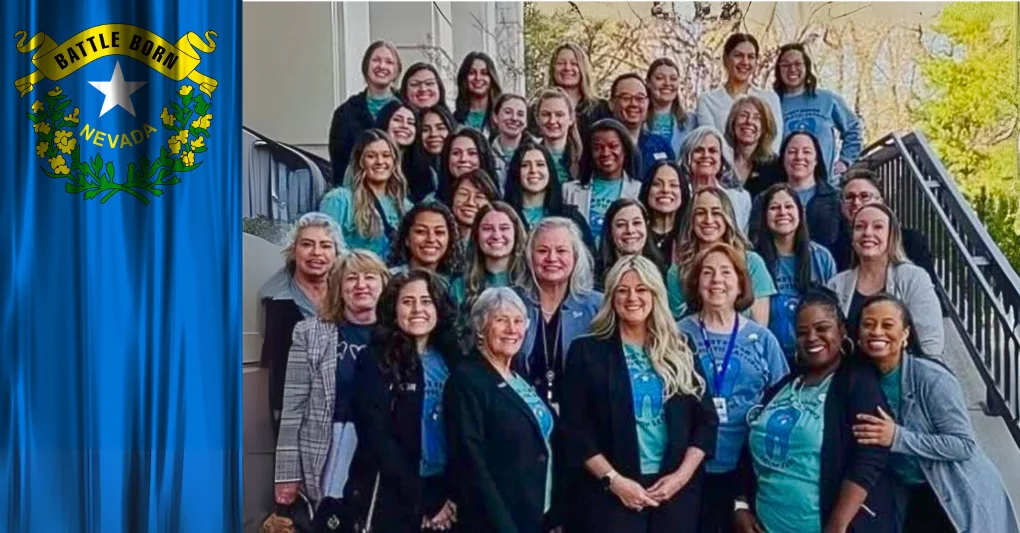By Diann Bomkamp, RDH, BSDH, CDHC, FADHA
November 5, 2025
Missouri dental hygienists: Join MDHA’s critical advocacy webinars on November 11 or 13 at 7:00 PM CT to learn how to fight this legislation and earn 1 CEU. Register here.
The Missouri Dental Hygienists’ Association (MDHA) is preparing for a bill pushed by the Missouri Dental Association that will make the Missouri Expanded Function Oral Preventive Assistant Pilot Project permanent. The scope of practice for an oral preventive assistant in this Pilot Project is limited to taking and recording periodontal probe readings, documenting areas of periodontal concern, and supragingival scaling and polishing. Oral preventive assistants shall be further limited to practice on periodontally healthy patients or patients with reversible gingivitis.
Looking at current data, there are now 3,639 licensed dental hygienists with an address in Missouri and 2,674 active licensed general dentists with a Missouri address.1 However, the rationale for the OPA in Missouri is that there are not enough dental hygienists in the workforce.
Administrative regulations established by the Missouri Dental Board define the OPA Pilot Project objectives to:
(A) Assess the treatment outcomes of oral preventive assistants for periodontally healthy patients and patients with reversible gingivitis from a clinical and patient experience perspective; and
(B) Determine if the use of oral preventive assistants can improve access to care by assisting in a limited scope of practice with periodontally healthy patients and patients with reversible gingivitis by creating more portal entry appointment opportunities for patients; and
(C) Determine if the addition of oral preventive assistants to the oral healthcare workforce can improve access to care for patients with more serious periodontal problems by enabling dental hygienists and dentists to use time previously devoted to periodontally healthy patients to serve patients with more serious or urgent periodontal needs.2
They further note that the OPA shall complete a board approved oral preventive assistant expanded function training course and apply for an expanded function permit issued by the Board. The EFDA Expanded Function Permits in Missouri include Restorative 1, Restorative 2, Removable Prosthodontics, Non-removable Prosthodontics and Orthodontics. Before taking an oral preventive assistant expanded function training course, a dental assistant shall successfully complete the Missouri Dental Assisting Skills exam administered by the Dental Assisting National Board or possess current certification as a Certified Dental Assistant from the Dental Assisting National Board.2 Note that the Missouri Dental Association trainers are providing the didactic portion of the training.
The Missouri Dental Board had to approve a “waiver” for this OPA Pilot Project. MDHA was not informed of the number of hours or the actual training of the EFDA OPA because the curriculum was described in an executive session meeting of the Missouri Dental Board since this information is considered “proprietary information” of the MDA. MDHA does know that the pilot program was not allowed in more than twelve sites, with half of them being in Class III (poorer) counties. A recent interim OPA Pilot Project report indicates that there are 16 OPA trainees in 7 sites.3
MDHA has prepared key points that need to be communicated to stop this upcoming bill.
- One of the main issues is to emphasize the lack of education and supervised instruction for this new Missouri provider, especially when compared to the accredited education of the dental hygienist. The lack of education of the OPA will not be enough to recognize the continually changing medical and oral health care needs of the patient. Quality of care is compromised, and patient safety is at risk.
- The few weekend hours of the OPA preparedness cannot compare to 3016 hours of accredited dental hygiene education.
- An OPA is often lauded as similar to a dental “military model” which is meant to prepare recruits for combat readiness and roles in the military, so they do not work in pain. The dental care that the recruits receive is not meant for life-long prevention or the comprehensive management of chronic oral diseases and should not be used as a model for civilian care. Military dental care is often a temporary fix for dental problems and poses the potential for legal and ethical risks utilizing a provider without sufficient knowledge.4
- This provider, being utilized under direct supervision, is inefficient. Direct supervision requires at least two checks by the dentist and possibly another visit to the dentist or hygienist to remove any subgingival calculus. This does not help reduce the hygiene shortage.
- Patients would be misled into thinking that they have received and paid for a thorough prophylaxis and should not be billed for incomplete care nor should facilities be paid for providing it.
- Patients cannot recognize what they don’t know, with their satisfaction levels being based on how little discomfort they receive or how nice their provider is, rather than quality of care.
- Who will know what the OPA is doing in someone’s mouth? Patients will not have the ability to judge the effectiveness of such care.
- Scaling only above the gumline is conducive to insurance fraud, since the only code that covers it is the D1999 code for “miscellaneous prevention”, which pays little. The “prophylaxis” codes are not appropriate for this care so it would be tempting for dental facilities to push for the OPA to either use this code or illegally scale below the gumline and to charge out for codes that pay more.5
- Dentists/employers will want to pay a lower wage to the EFDA OPA who may already be overworked as a dental assistant.
- There is no research to support supragingival scaling alone, which can actually harm a patient, leading to periodontal abscesses and worsened oral health outcomes through insufficient care.6,7,8
- It is possible but not likely for a provider to stop scaling at the gingival margin to prevent scaling below the gumline.
- The OPA can only treat the underserved population, so this group, who needs the care most, will get substandard care by the least educated provider. Most patients in this category will not have periodontally healthy mouths and reversible gingivitis.
- Just having more providers with less education does not mean the dental access problem will be solved. The OPA will not be able to solve the real need for dental hygienists. Missouri needs more dental hygiene graduates, a work culture that is respectful and conducive to good care, with incentives for hygienists to return or remain in the work force.
- “MDHA wants to Stop the Substandard Dental Care Bill”
____________________________________
References
- Missouri Division of Professional Registration. Professional licensing database. Accessed October 11, 2025. https://www.pr.mo.gov/.
- Missouri Department of Commerce and Insurance. “Amended Version of the EFDA-Oral Preventive Assistant (OPA) Pilot Program.” Title 20, Division 2110-2. February 7, 2024. https://www.sos.mo.gov/CMSImages/AdRules/csr/current/20csr/20c2110-2.pdf.
- Deyton, Guy. “Missouri Office of Dental Health Pilot Project: Training and Deploying Oral Preventive Assistant Expanded Function Dental Assistants to Address Oral Healthcare Workforce Shortages in Medicaid and Rural Clinics in Missouri.” Interim report to the Missouri Dental Board, October 10, 2025.
- Bomkamp, Diann. “Adopting Substandard Military Preventive Dentistry Models Is Not the Answer to Solving the Dental Hygiene Workforce Shortage.” Dentistry IQ, 2025. https://www.dentistryiq.com/dental-hygiene/article/55305332/adopting-substandard-military-preventive-dentistry-models-is-not-the-answer-to-solving-the-dental-hygiene-workforce-shortage.
- Forbes, Kristine S. “Are D1110/D1120 the Proper CDT Procedure Codes for Oral Preventive Assistants/Scaling Assistants?” RDH, July 1, 2025. https://www.rdhmag.com/patient-care/dental-coding/article/55300647/are-d1110-d1120-the-proper-cdt-procedure-codes-for-oral-preventive-assistants-scaling-assistants.
- Kacerik, Mark. “Changing Trends in Periodontal Debridement.” Dentistry IQ. Accessed November 5, 2025. https://www.dentistryiq.com/dental-hygiene/clinical-hygiene/article/16355331/changing-trends-in-periodontal-debridement.
- Wilkins, Esther M. Clinical Practice of the Dental Hygienist. 8th ed. Philadelphia: Lippincott Williams & Wilkins, 1999.
- Nield-Gehrig, Jill S. Fundamentals of Periodontal Instrumentation & Advanced Root Instrumentation. 5th ed. Philadelphia: Lippincott Williams & Wilkins, 2004.
____________________________________
 Diann Bomkamp, RDH, BSDH, CDHC, FADHA, has been a dental hygienist and ADHA member since 1970. As a long-time member of the ADHA, Diann has served various leadership and mentorship roles on regional and national levels. Regionally, she served in the Greater St. Louis Dental Hygienists’ Association, MDHA and the Missouri Hy-PAC. Nationally, she has served on a number of ADHA committees, as District VIII Trustee and as ADHA President 2008-2009. Diann is a strong advocate for Missouri dental hygienists. She instills the value of professionalism, mentorship, integrity, commitment, and service. Diann has worked tirelessly to protect, promote, and advance the profession of dental hygiene in the State of Missouri.
Diann Bomkamp, RDH, BSDH, CDHC, FADHA, has been a dental hygienist and ADHA member since 1970. As a long-time member of the ADHA, Diann has served various leadership and mentorship roles on regional and national levels. Regionally, she served in the Greater St. Louis Dental Hygienists’ Association, MDHA and the Missouri Hy-PAC. Nationally, she has served on a number of ADHA committees, as District VIII Trustee and as ADHA President 2008-2009. Diann is a strong advocate for Missouri dental hygienists. She instills the value of professionalism, mentorship, integrity, commitment, and service. Diann has worked tirelessly to protect, promote, and advance the profession of dental hygiene in the State of Missouri.



